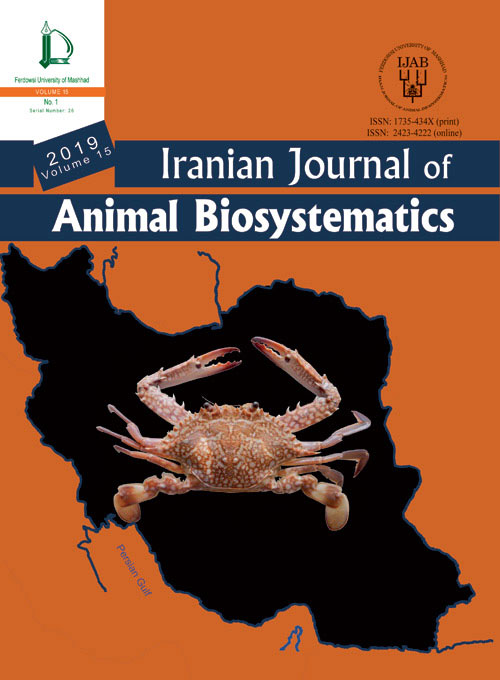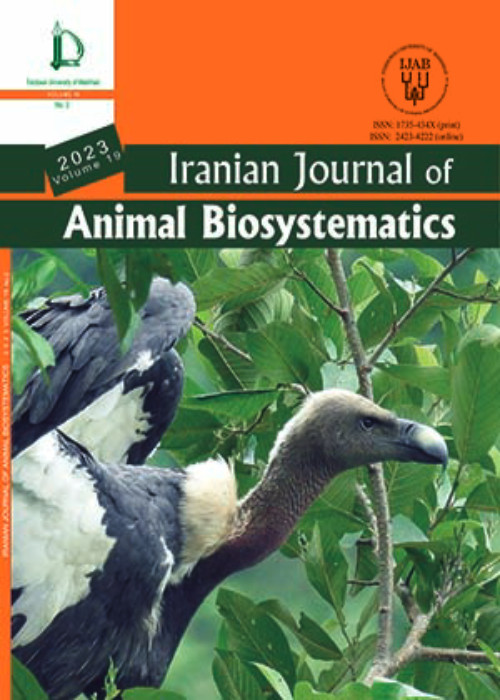فهرست مطالب

Iranian journal of animal biosystematics
Volume:15 Issue: 2, Summer-Autumn 2029
- تاریخ انتشار: 1399/02/16
- تعداد عناوین: 8
-
-
Pages 116-124
The Bedraiga's skink gecko, Teratoscincus bedriagai, is among the fairly known lizards of Iran. Phylogenetic relationships among five distant populations of Teratoscincus bedriagai were estimated based on the mitochondrial COI sequences. This study highlights very low genetic divergences among examined populations despite the noticeable geographic distance between them. We assumed that the current distribution pattern of haplotypes is shaped as a consequence of climate changes and glaciations in the Quaternary.
Keywords: Genetic distance, Teratoscincus bedriagai, Iran, Sphaerodactylidae, Quaternary -
Pages 125-136
Habitat with its components is the most important need of wildlife species. So that, habitat management is a critical procedure in wildlife conservation. In the present study, desirable habitats of Kavir National Park for Wild goat are determined in two distinguished warm and cold seasons, applying Random Forests, Maximum Entropy, and Classification Tree algorithmsa and for this matter “Salford Predictive Modeler” and MaxEnt software were used. Consequently, an ensemble habitat suitability map was provided based on weight-averaging method. The results illustrated that elevation, water resources, vegetation type, and slope are the most important factors in predicting Wild goat’s suitable habitats with a slightly different impact on each season. In general, among the existing plant species, Wild goat prefers Artemisia sieberi, Stipa arabica, Zyghophylom eurpterum, and Sieditzia rozmarinus. Also, the altitudes higher than 1050 meters above sea level, slopes over 20 to 35 percent, and distances less than 5,000 meters to water resources are desirable. Meanwhile, several suitable patches for Wild goats were found which are greatly in need of conservation. Considering the importance of water resources in this region, in order to improve the quality of the habitat, further study on water resources status is suggested.
Keywords: Wild goat, Kavir National Park, habitat suitability, MaxEnt, random forest, classification, regression tree -
Pages 137-146
Aquatic Coleoptera play an important role in freshwater ecosystems and are considered as a suitable bioindicator. Despite being widely distributed in Iran, there are few studies in which aquatic Coleoptera are used to assess ecological quality and environmental conditions. With abundant water resources, Chaharmahal & Bakhtiari province, Iran, provides an excellent opportunity to explore the influence of environmental features on aquatic beetles. This research was aimed were to investigate community structure and to determine the dominant factors controlling aquatic beetles in the Borujen and Lordegan (as two main towns of the province). Using standard sampling tools (a small net and soft paintbrush), sampling was done seasonally for one year (between Sep. 2017 to July 2018) at six stations, also at each station ecological factors such as water temperature, water pH, water electrical conductivity and air temperature were measured by means of appropriated instruments. A total of 12 species belonging to 11 genera and 4 families were identified. The greatest number of species identified were found in the family Dytiscidae and the least number in the family Hydrophilidae. Two species of Agabus namely, Agabus conspersus and Agabus bipustulatus were the most abundant insects. Linear regression analysis showed that water temperature with correlation coefficient of 1.685 was the most effective factor in the distribution of aquatic Coleoptera and the air temperature with a correlation coefficient of 0.39 was the least important factor. In addition, canonical correspondence analysis (CCA) disclosed that water pH, water electrical conductivity (EC), water temperature (WT) and air temperature (AT) had an impact on the distribution of aquatic beetles. Our results suggest that water quality plays a key role in species richness of aquatic beetles, and that therefore they could be considered as an indicator organism of freshwater ecosystem health.
Keywords: Aquatic Coleoptera_Chaharmahal & Bakhtiari_Dytiscidae_Ecological Factors_Water temperature -
Pages 147-156
In this study, earthworms were collected from the wetlands of Sistan at 17 stations. The following nine species were identified: Aporrectodea caliginosa (Savigny, 1826), Ap. jassyensis (Michaelsen, 1891), Ap. longa (Ude, 1885), Ap. rosea (Savigny, 1826), Ap. trapezoides (Dugès, 1828), Bimastos parvus (Eisen, 1874), Eisenia andrei/fetida complex, E. omranii Latif, Malek and Csuzdi, 2017, and Eiseniella tetraedra (Savigny, 1826). All species comprise a new record for the east of Iran. The most frequent species were Ap. rosea and Ap. caliginosa; and the rarest one was E. andrei/fetida. Length and total earthworm segments of each species were compared between specimens of Sistan and previous known values from Elburz (north of Iran) and/or Zagros (west of Iran) regions.
Keywords: Earthworm, Lumbricidae, New record, Sistan, Balouchestan, Iran -
Pages 157-170
Data on distribution and fauna of cave-dwelling bat species from Iran is infrequent. Recent studies in certain parts of the country especially the western and southwestern regions demonstrated a high level of species richness for chiropteran fauna. Since Lorestan province is located in the middle of Zagros mountain ranges, and a considerable number of bat species are living in the adjacent provinces; it is expected that Lorestan also harbors a great number of bat species. In the present study, 49 caves were investigated of which 48 caves were found to be occupied by 1 to 3 bat species. Bats were identified using identification keys, measured, photographed, and then released. A total number of 68 records from 11 species was documented in this study. The identified species include Rhinopoma hardwickii, R. muscatellum and R. microphyllum from family Rhinopomatidae, Rhinolophus ferrumequinum, Rh. hipposideros, Rh. euryale, Rh. mehelyi and Rh. blasii from family Rhinolophidae, Myotis blythii and M. capaccinii from Vespertilionidae family, and Miniopterus pallidus from Miniopteridae family. Rh. ferrumequinum with 19 observation records had the highest distributional range. Furthermore, the biggest colony comprising several thousands of individuals of R. microphyllum was observed in Khofash Big Cave. Myotis capaccinii, Rhinopoma microphyllum, Rhinolophus blasii, and Rh. mehelyi were observed for the first time in Lorestan province.
Keywords: Chiroptera, distribution, fauna, Lorestan Province, Zagros Range -
Pages 171-174
Species of Anurophorus Nicolet, 1842 (Collembola: Isotomidae) mostly occur in forest habitats. They are usually dark in colors and characterised by absence of furca. During 2018, a survey was conducted for Collembola in Mazandaran province (Northern Iran). Some Isotomdiae specimens were extracted from soil, moss and decaying wood samples using Berlese funnel. Among the collected samples from family Isotomidae some specimens of Anurophorus silvaticus Potapov & Stebaeva, 1990 were also identified. The species is reported for the first time from Iran. We provide the description, including photos of A. silvaticus based on the Iranian material.
Keywords: Anurophorinae, biodiversity, Hyrcanian forest, Mazandaran -
Pages 175-188
In late summer 2016, the first author collected 34 specimens from nine species of Mantodea from Lorestan, chiefly Kuhdasht, Eastern part of the province. Although nine species were determined as new records for this part of the country, more searches in different seasons may lead to finding more species even new ones because this group of insects poorly studied in Iran especially in mountainous western part of the country. It is argued that much more diversity from a short time collecting effort is an evidence of our poor knowledge of the fauna of Iranian mantids. The present work is the first study on this region of Lorestan province which led to reporting nine species for the first time namely, Blepharopsis mendica, Empusa hedenborgii (Empusidae), Ameles persa, Bolivaria brachyptera, Mantis religiosa, Microthespis dmitriewi, Oxyothespis persica, Rivetina caucasica (Mantidae), Iris oratoria (Tarachodidae).
Keywords: Zoology, Mantodea, Mantids, Iran -
Pages 189-193
The first record of Montivipera kuhrangica from outside of its type locality is introduced from a high elevation area of Isfahan province, Iran. The specimens are morphologically consistent with the type-specimen's description, except for the Loreal and Infralabial scales.
Keywords: New Record, Iran, fauna, phylogeny, viperidae, snake


